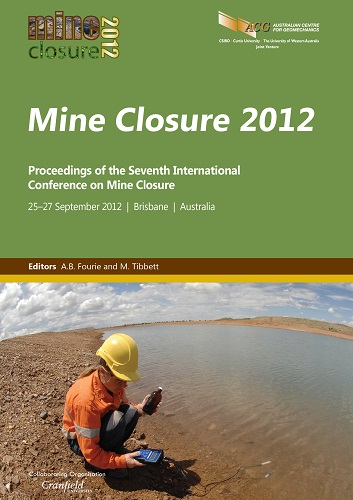Evolution of cover system design and waste rock management at a mine in the Pilbara region of Western Australia

|
Authors: Bonstrom, K; Allen, G; O'Kane, MA; Christensen, D Paper is not available for download Contact Us |
DOI https://doi.org/10.36487/ACG_rep/1208_32_Bonstrom
Cite As:
Bonstrom, K, Allen, G, O'Kane, MA & Christensen, D 2012, 'Evolution of cover system design and waste rock management at a mine in the Pilbara region of Western Australia', in AB Fourie & M Tibbett (eds), Mine Closure 2012: Proceedings of the Seventh International Conference on Mine Closure, Australian Centre for Geomechanics, Perth, pp. 351-363, https://doi.org/10.36487/ACG_rep/1208_32_Bonstrom
Abstract:
Since 1995, cover system designs and waste rock management plans have been developed for the waste rock dumps (WRDs) at a mine in the Pilbara region of Western Australia. A major component has been investigation of acid metalliferous drainage (AMD) from the WRDs and development of management strategies to limit impacts to receiving environments. The site’s management strategies have focused on cover system design as well as landform and watershed designs. WRD landform design, and associated cover system design, has evolved several times since 1995. This has occurred in response to evolution of the conceptual models that have been developed at the site with respect to the mechanisms, and the controls on those mechanisms, resulting in AMD. The information gathered over a period of 15 years led to changes in the conceptual model. Prior to 1995, AMD was thought to be, in general, a ‘non-issue’ in arid environments similar to the Pilbara region. However, in 1995, the first appearance of AMD at the site occurred in response to a major cyclone. The first conceptual model for cover system performance was developed in 1995 with the main aim of limiting net percolation (NP) to the underlying WRD. This design was a ‘simple’ cover system that used the ‘moisture store-and-release’ concept, relying on evaporation to cycle moisture back to the atmosphere and a hummocky surface to limit runoff and runoff-induced erosion. At that time, no vegetation was included in the conceptual model as it was considered that bare surface evaporation would be sufficient. The conceptual model for cover system performance has evolved since 1996. The model still utilises the ‘moisture store-and-release’ concept; however, incorporating cover construction QA/QC, optimising transpiration through sustainable vegetation, and managing runoff through catchment design have been refined and incorporated into full-scale WRDs. Since 1996, several research test piles, cover system field trials, and vegetation test plots have been constructed and monitored to measure their effectiveness in meeting AMD management objectives at the site. Fifteen years of data from the large cover system field trials constructed in 1996 and 2002 have resulted in key findings influencing long-term closure plans. NP into WRDs has been limited to 5% of average annual rainfall over 13 years of monitoring for a 2 m thick run-of-mine (ROM) cover system. Where a 4 m thick cover was constructed, NP has been limited to substantially less than 5% over 13 years. It has also been found that segregation of the ROM cover material, as well as selective handling of potentially acid forming wastes, strongly influences AMD management. Short, medium, and long-term strategies were developed in 1996 to manage AMD at the site, identify mechanisms (and their controls) for AMD, and develop waste management practices to mitigate AMD. Short-term strategies that were introduced included containing runoff, identifying research goals, characterising the waste, and initiating management and rehabilitation plans. Research into strategic selective handling and placement of acid forming and non-acid forming overburden has also been monitored and evaluated. Long-term closure strategies are being implemented on site based on confirmation of the effectiveness of the field research and rehabilitation strategies.
References:
O’Kane, M. and Waters, P. (2003) Dry Cover Trials at Mt Whaleback — A Summary of Overburden Storage Area Cover System Performance, International Conference on Acid Rock Drainage, Cairns, QLD, Australia.
OKC (1998) O’Kane Consultants Inc. year One Field Test Plot Performance Report No. 1 and No. 2 (August, 1997 ~ December, 1997) Mt Whaleback, Submitted to BHP January 1998, p. 3.
Porterfield, D.C., Miller, S. and Waters, P. (2003) A Strategy for Managing Acid Rock Drainage in Arid Climates — The Mt Whaleback Story, International Conference on Acid Rock Drainage, Cairns, QLD, Australia.
Waters, P. and O’Kane, M. (2003) Mining and Storage of Reactive Shale at BHPBilliton’s Mt Whaleback Mine, International Conference on Acid Rock Drainage, Cairns, QLD, Australia.
© Copyright 2025, Australian Centre for Geomechanics (ACG), The University of Western Australia. All rights reserved.
View copyright/legal information
Please direct any queries or error reports to repository-acg@uwa.edu.au
View copyright/legal information
Please direct any queries or error reports to repository-acg@uwa.edu.au